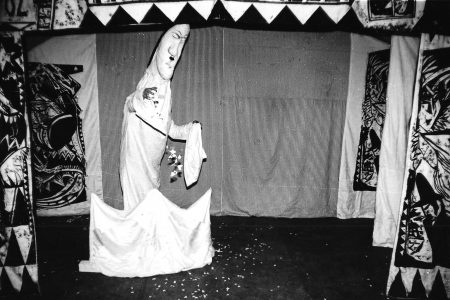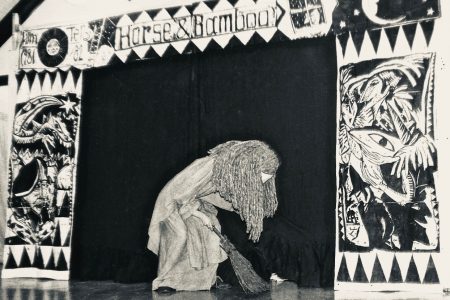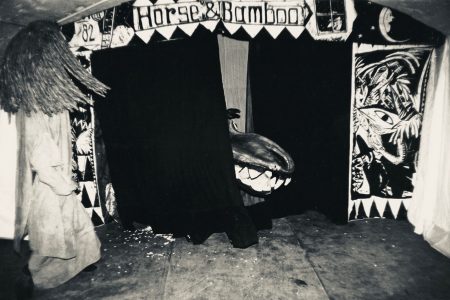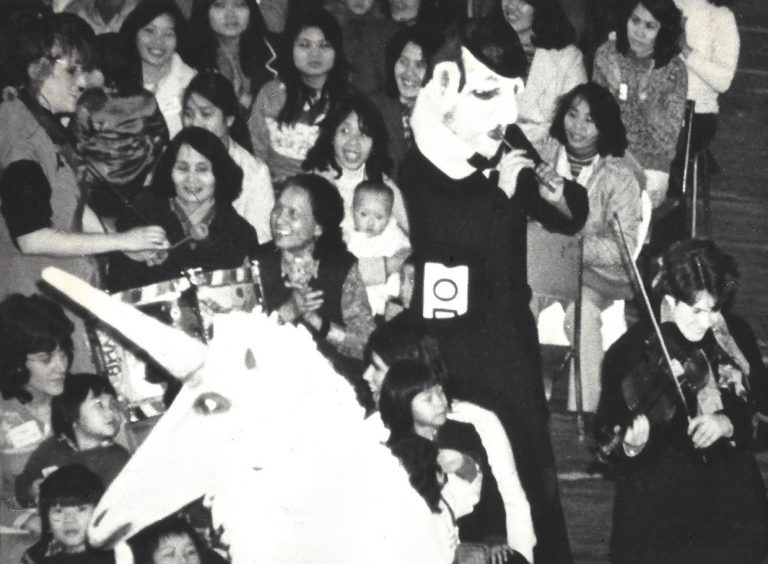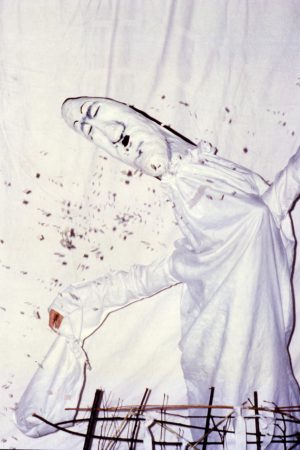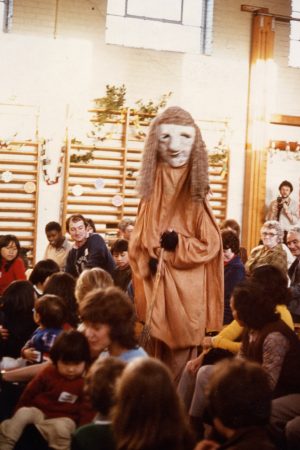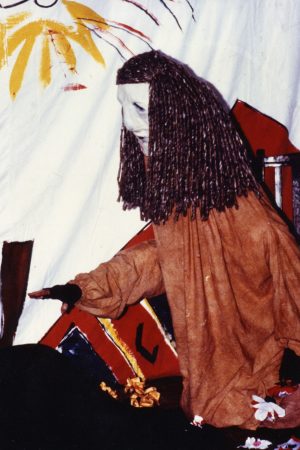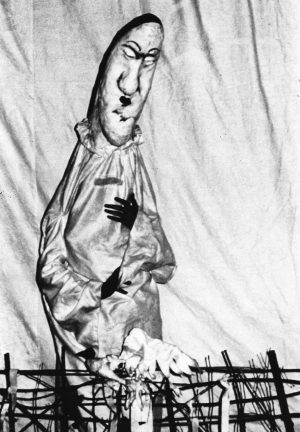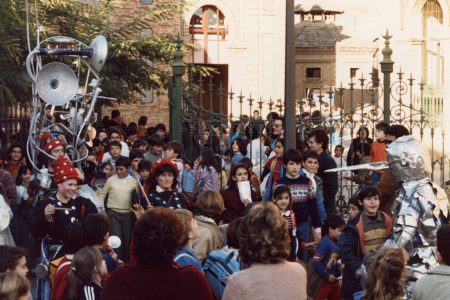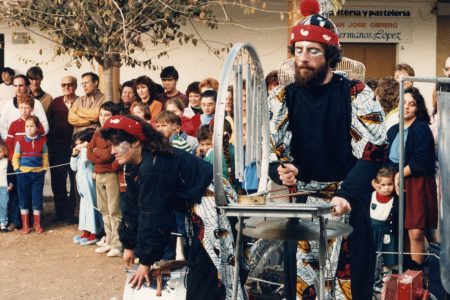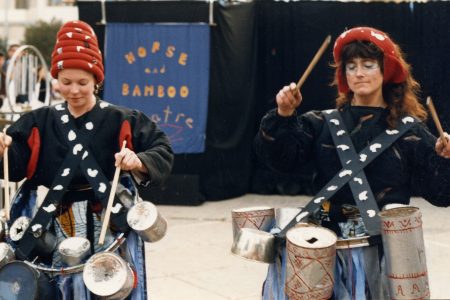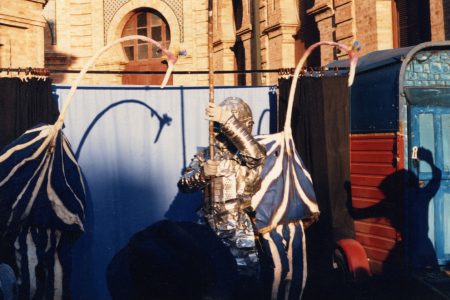1980: Angel Mummers
During our first couple of years we used a battered Moskvitch with a leaky fuel tank and then a battered Morris Traveller as support vehicles for the horse-drawn tours. In 1980 we bought a Sherpa crew-bus which meant that we could also consider touring a show without horses. Horse-drawn tours usually finished in September, once the weather got too cold for comfortable camping. So, we developed a new story for a van tour using a relatively small cast of 6. It combined elements of traditional mumming plays combined with the Christmas story. From December 1980 until March 1981 we toured this show, which was simply called Winter. We called the troupe the Angel Mummers, and we took it to Derbyshire, Leicester and Cheshire, as well as locally.
Morton Hall Boat People
The show was finely made, with a beautiful hand-printed cloth set decorated with woodcuts. I made the prints and the masks, and the costumes were lovingly created and sewn by Jane Matthews and Viv Howard, from Manchester Polytechnic. Kay Kennedy played the central character, Old Mary, and Gill Pearson joined us as musician and administrator.
The show was first used at Morton Hall Refugee Camp, near Swinderby in Lincolnshire, in December 1980. It was an old RAF station where the ‘bouncing bomb’ had been developed. It was sitting waiting for the government to use in an emergency. Nowadays it’s an Immigration Removal Centre, notorious for a number of unexplained deaths amongst its inmates. An old acquaintance of mine, Alan Daniels, was then the Secondary Education Officer with the County Council. Alan had the job of managing just such an emergency in 1980 – the sudden influx into the UK of Vietnamese ethnic-Chinese refugees. It was all under the radar as Mrs Thatchers government didn’t want to advertise the fact of its existence. This was because official policy was against enabling any immigration at all.
Alan’s idea was that Horse + Bamboo could move into the camp for the Christmas period. This would allow some of the staff a much-needed Christmas break whilst providing the refugees with seasonal entertainment. We gathered a team who could spare a couple of weeks over Christmas – myself, Kay, Gwyneth Lamb our musician, Peter Lindhout, Jane Matthews. Between us we concocted a series of events for the period. Performances of Winter; parades with our Dragon; fire and fireworks. It was all gloriously strange and rather odd. For the Vietnamese refugees I’m not sure how it must have appeared, as our mumming/Christian colour symbolism was topsy-turvy for them. For example, the villain in our show, the Red Dragon, suggested instead a hero. Our friendly white angels they associated with death…and so on. Still, it livened up the otherwise monotonous life of a rather grim camp.
Then after Christmas Sue Auty and Edward Taylor joined us for a tour. Gill Pearson took over the music from Gwyneth. On a few occasions we performed the full theatre show. But Angel Mummers appeared as often as not as a pub mumming show with live music, or even as a street event. Edward made a great MC, along with the cast of Old Mary, a Salesman, a Dragon, a unicorn and two noisy soldiers armed with fireworks. Winter was uncharacteristic of the company’s work, probably because the story was very close to being a traditional mumming play.
1985: La Dama Azul
In 1985 we spent the summer moving from our workshop in Irwell Vale to a larger and better equipped space in Rawtenstall. We were also invited to take part in the Spanish International Puppet Festival in Seville. It was the period of the first left-leaning government in Spain since the death of Franco. For much of the country there was a great mood of optimism and a cultural re-awakening. The company was offered a fee that didn’t cover our costs but we felt the opportunity was too good to miss. The British Council also decided to give us a contribution towards the show. In turn we asked the festival if they would allow us to tour the rural areas in Sevilla Province rather than simply perform in the city. The authorities needed a little persuasion but, eventually, it was agreed to with a shrug of the shoulders.
We tightened our belts to create a small, cheap show, redeploying our horse trailer as an outdoor theatre. In November we took the ferry to Santander, and drove our van and the trailer down to Andalusia and Seville, where we all stayed together at Hotel Goya, in the beautiful Jewish Quarter.
In Seville we were amazed to find that main roads would be closed off by the police for several hours at a time in order to create the space for a street show. People grumbled, and car horns would be sounded. But once everyone realised it was for a theatre show then everything was suddenly cool, no problem. Most motorists just stayed around and watched the show. I was impressed that audiences instinctively knew how to create a circle so everyone could see things well. A site that would barely lend itself to 50 spectators in England, since above that number the sight-lines would be blocked, could magically accommodate 200 or more in Spain. Everyone sorted themselves into good order without so much as a word having to be uttered. This skill seemed to be instinctive.
Our decision to perform in the small hilltop pueblos in the countryside really paid off. People were delighted to see entertainers arriving in their towns and villages for the first time in decades. Large crowds assembled just to watch us set up our show. A good piece of setting up would be awarded with a round of applause. This would go on for hours. It also astonished people that the show was being offered for free, and impromptu flamenco performances by people of all ages were put on, at short notice, as repayment to us in return for our show. These unforgettable improvised dance sessions would go on late into the night. They involved both young and old from the pueblo, everyone clapping the flamenco rhythms for the dancers.
The whole experience was amazing, especially as the post-Christmas ferry home closed down for a two week break, so a handful of us had to stay in Spain throughout the Christmas and New Year period. We used this time to slowly make our way north back to Santander for early January in order to catch the first ferry back after the break. On New Years Eve we joined a crowd in the plaza of a Catalan hill town. Grapes were eaten as the clock struck midnight; wishes were made and hundreds of bottle of cava were thrown into the air to smash into pieces in a giant explosion on the cobbles. Then a mysterious group of dwarves arrived out of nowhere and led us all away to a nightclub on the edge of town.
BOB FRITH, MOIRA HIRST, ANNE BARBER, MELISSA WYER, DAVE KING (m), SALLY MARTIN (admin)
